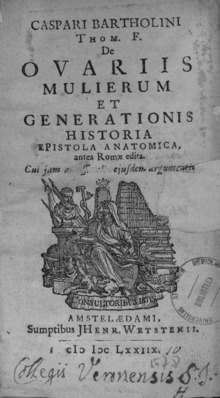Caspar Bartholin the Younger
This article needs additional citations for verification. (December 2014) |

Caspar Bartholin the Younger (/bɑːrˈtoʊlɪn, ˈbɑːrtəlɪn/;[1] Latinized: Caspar Bartholin Secundus; 10 September 1655 in Copenhagen – 11 June 1738), was a Danish anatomist who first described the "Bartholin's gland" in the 17th century.
He came from an eminent family. He is the grandson of theologian and anatomist Caspar Bartholin (the Elder) and son of Thomas Bartholin. His uncle was Rasmus Bartholin and his brother, a historian, was called Thomas like his father.
The discovery of the Bartholin's gland is sometimes mistakenly credited to his grandfather.
Caspar Bartholin the Younger started his medical studies in 1671 at the age of 16. When he was 19 he was appointed as professor of philosophy. He described the glands that bear his name in 1677.
In about 1696, Danish-born French anatomist Jacob B. Winsløw was Bartholin's prosector.
Works
- De tibiis veterum et earum antiquo usu, p. PP7, at Google Books. Rome: B. Carrara, 1677 (Bartholin also wrote about music)
- De ovariis mulierum et generationis historia epistola anatomica, p. PA1, at Google Books. Amsterdam: J. H. Wetstein, 1678
References
